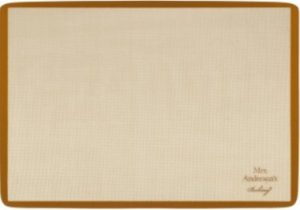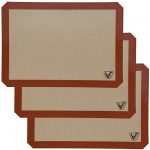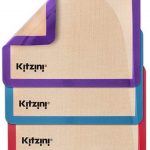7 Best Silicone Baking Mats by 2024 Ratings
It’s a common source of frustration for all bakers, where you slave over your delicious desserts and just as everything is coming together, your baked goods get stuck to the baking surface or you don’t have enough parchment paper to use as the non-stick surface, or you can’t rip the parchment paper from its box without it tearing. This can be frustrating and even fairly disheartening to some because it means having to start from scratch, unless you like your desserts burnt.
 The greatest convenience for bakers is being able to guarantee that they have a non-stick surface for when they make their baked goods. While there is the option of using oil, cooking spray, or flour on the baking pan, this is inadvisable as you can’t use this method across the board. For example; when making cookies, you run the risk of over-browning or over-spreading.
The greatest convenience for bakers is being able to guarantee that they have a non-stick surface for when they make their baked goods. While there is the option of using oil, cooking spray, or flour on the baking pan, this is inadvisable as you can’t use this method across the board. For example; when making cookies, you run the risk of over-browning or over-spreading.
Especially for those who are new to baking, one must wonder; is there no solution for this problem? Are there any options? Well fortunately, the answer is yes! The smartest way to resolve this problem is through the purchase of a silicone baking mat. Made with a combination of food-grade silicone and fiberglass, these mats are very simple to use and have proven to be extremely convenient to bakers for several years now.
What is a Silicone Baking Mat Used For?
Simply put, these mats are used for baking (or even cooking) when a non-stick surface is needed. However, to be more specific there’s a whole lot one can do with a single silicone baking mat, in fact one could even potentially argue that these mats can be used for virtually anything.
The different uses it provides are listed as follows:
- The non-stick surface is excellent for making dough and pastries because everything cooks evenly (fiberglass doesn’t retain heat in the manner that metal pans do).
- They’re great for making anything sticky. Professional chefs make use of these mats for things like fondant, caramel, chocolate, etc.
- Very diverse. Silicone mats aren’t confined to purely baking, one can use them to make all sorts of food! Examples include (but are not limited to):
– Chicken
– Burgers
– Fish
– Vegetables
– Steak
– Pancakes
– Eggs - Size variety. They come in a whole bunch of different sizes to suit whatever needs you might have. Some of the available sizes are:
– The Half Sheet size
– The Full Sheet size
– The Cookie Baking sheet
– The Pretzel Baking sheet
– The Macaroon mat - A great surface for kneading bread as one doesn’t have to worry too much about the bread sticking to the surface.
- Excellent for grilling. This is because the silicone mats can be placed on any sort of grilling set up. Whether its charcoal, gas, or electric these mats can withstand it all and provide a great meal as the end result.
- Reduced chances of burning. As mentioned earlier, these mats don’t retain heat like a metal pan so the odds of burning look a lot slimmer.
Are Silicone Baking Mats Safe?
As stated earlier, these mats are made through a combination of fiberglass and silicone. Fiberglass is a kind of fibre-reinforced plastic. The fibre in question is actually glass (these fibres can be made using various kinds of glass). Meanwhile, silicone is a man-made polymer created by combining either carbon or oxygen with naturally occurring chemical element silicon. According to the FDA, silicone (which is to say the synthetic polymer), is classed as safe for food and is generally considered chemically inactive.
However, at the same time it would be remiss to not acknowledge the lack of proper scientific research into the matter. So truthfully, there isn’t much evidence in either direction to properly form an answer. Though of any testing that has been conducted, it’s primarily been focused on medical grade silicone (these were tested with the absence of additives or fillers). The results of these studies show that silicone is safe at body and room temperatures, though there is insufficient data on how it responds at very high temperatures.
While research isn’t in a position to support any potential downsides, there is some anecdotal evidence one could reference. These include: a higher chance for leeching, a particular odour, fillers used in lower quality silicone. However one need not be afraid.
These things have only been observed at very high temperatures so essentially silicone baking mats can be considered safe for food. As with most baking/cooking related tools, it’s advisable to work with high quality versions as there’s a greater amount of risk involved when using a lower grade version.
7 Best Silicone Baking Mats List
What Temperatures can these Mats Withstand?
Based on the way these mats are advertised, one will notice that the mats are marketed as being able to withstand temperatures below freezing point up to 450oF (232oC). These advertised temperatures lend credence to the idea that silicone bake-ware is largely safe for food. Additionally, silicone itself as a material is capable of handling indirect heat of up to 500OF, which is similar to most home ovens on their highest setting.
Due to the nature of the substance, silicone distributes heat evenly (as mentioned earlier), and it also cools fairly fast. Depending on your needs, they can be put in freezers and microwaves, However be mindful that you don’t use them over an open flame or under a broiler because silicone mats cannot be exposed to direct heat.
Generally speaking, the range for maximum temperatures it can withstand is about 428oF to 500oF. At the same time, it’s still better to check your respective product for instructions/advice before using.
Why not Parchment Paper?
Parchment paper is another non-stick surface. It’s essentially a sheet of paper coated with a layer of silicone. It’s easy to conclude that it fulfils the same purpose as a silicone sheet, so why isn’t parchment paper a more viable option? Especially considering it can easily be adapted to various pans and moulds with nothing but a pair of scissors.
The biggest difference-maker between parchment paper and silicone mats is that the mats are renewable and more cost efficient. The problem with parchment paper is that you can only use a sheet a single time before having to dispose of it, not to mention one has to make sure they’re taking out the correct amount from the box it’s stored in.
Arguably a fair bit of waste occurs with parchment paper, and having to refill the stock every so often can get pricey. The mats, by comparison, needs to be cleaned and can be used up to 3000 times with proper care. So while a mat may be more expensive in the short term, it’ll save more money in the long run and will help to save some trees by using less paper 🙂
Silicone Baking Mats vs Parchment Paper
Well, lets start with silicone bats first. As we know they are flexible and reusable. Made from fiberglass and silicone and size variety and shapes offered by current technology can fit any chefs needs. On the other hand, parchment paper is a pure cellulose and that should say to us to use because of ecology and all other things, but the point is that they are coated with silicone, and the reason of doing so is to make them non-stick. Of course, paper is way cheaper but it’s not reusable and if you are in to ecological materials you should consider this perceptive – one-time usage vs multiple usage. It’s all about waste.
Many people say that paper is better because it does the work better but if comparing to silicone mats, you can use them multiple times and there is not waste. Not only that, but everybody knows that mats offering much better crisping with cookies or any other similar products such as cheese crisps.
If you want to know more about the difference, watch the video:
Cleaning Silicone Baking Mats
Most silicone mats are manufactured to be dishwasher safe, though some still prefer to wash them manually. Though as far as dishwashers are concerned, running a normal cycle should be enough.
Other handy tips to clean your mats include using lemon juice. Here, you soak the mat in hot water for 10 minutes with a little fresh lemon juice. Then scrub it clean while it is still submerged in the water. You would need to don their kitchen gloves and find a towel or sponge to finish the job.
Another trick one involves baking soda. In this, you place the mat under running water for a bit. Once finished, the water is turned off and then a generous amount of baking soda is sprinkled over it. Again, don your kitchen gloves and rub the soda and the water to create a paste. Make sure to focus the paste on the parts with the toughest stains. Leave the mat with the paste on it for about 20 minutes after which you can rinse it off.
The last suggestion is to use extremely hot water and grease fighting soap. Here, the mat will be soaked in piping hot water and a few squirts of a strong grease fighting soap for 20 minutes. While the mat is still underwater, it is to be scrubbed with a towel or sponge in the stained areas.
Each of these methods can be repeated as necessary. Additionally, regardless of the method used the mats can either be left to air-dry on a rack or be dried off with a towel. Check out video below to see how it exactly looks like.
Conclusion
On the whole, silicone mats are invaluable to a kitchen. Used by professionals and amateurs alike, there is great utility to having one on hand. One can use these mats to create desserts or savoury food and find their lives made much easier with this renewable non-stick surface. The only thing to watch out for is proper maintenance. A well looked after silicone mat will last its owner up to 3000 uses. This is in strong contrast to alternatives like foil or parchment paper, which will consistently require restocking for the kitchen.
While some do have concerns about using a material like silicone for bake-ware (or anything food related), most of these concerns are tied to what kind of temperatures the mats can tolerate. Seeing that they’re capable of handling the same amount of heat as most ovens does much to alleviate quite a few of these concerns.
Ultimately, a silicone baking mat is a great tool for any kitchen and is highly recommended by anyone who cooks or bakes.


